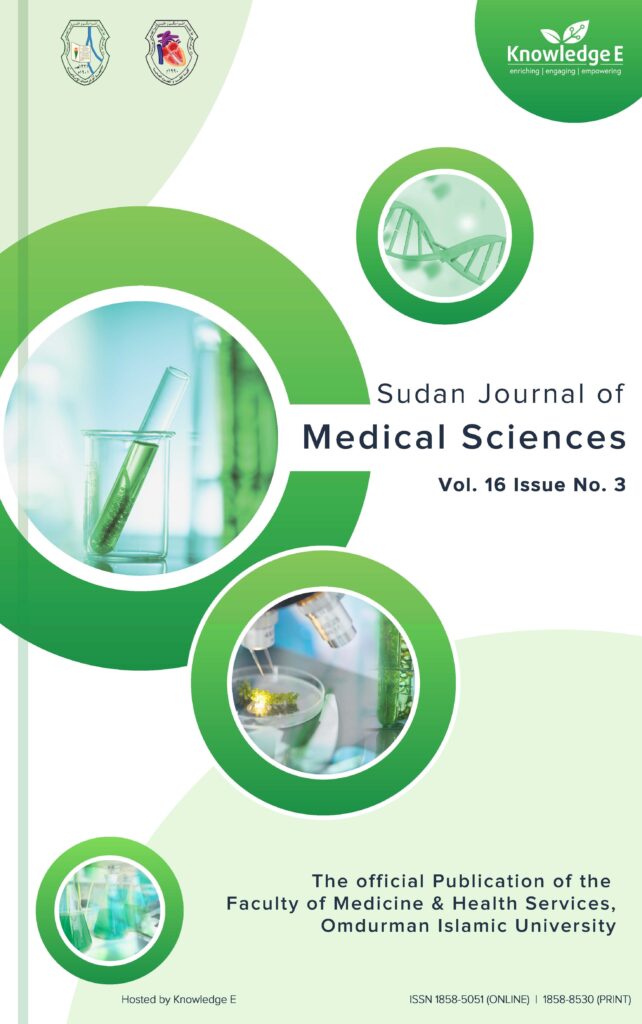
Sudan Journal of Medical Sciences
ISSN: 1858-5051
High-impact research on the latest developments in medicine and healthcare across MENA and Africa
Assessment of Variation in Clinical Presentation of Visceral Leishmaniasis Among Patients Attending the Tropical Diseases Teaching Hospital in Sudan
Published date:Sep 30 2022
Journal Title: Sudan Journal of Medical Sciences
Issue title: Sudan JMS: Volume 17 (2022), Issue No. 3
Pages:341 - 354
Authors:
Abstract:
Background: Visceral leishmaniasis (also known as Kala-azar) is a systemic parasitic infection with many clinical presentations. The present study assesses the variation in presentations among patients who attended the Tropical Diseases Teaching Hospital (TDTH) in Khartoum, Sudan.
Methods: This analytical cross-sectional, hospital-based study was conducted at the TDTH between November 2019 and September 2020. Medical records of patients who presented at the TDTH were reviewed using a structured data extraction checklist. The Chi-square test was used to determine the associations between sociodemographic and clinical presentations of patients. P-value < 0.05 was considered as statistically significant.
Results: Out of 195 patients, 79.5% were male and 48.2% were <31 years old. Fever was the main clinical presentation (90.2%) while 53.3% presented with weight loss and 72.3% and 39% presented, respectively, with splenomegaly and hepatomegaly. HIV was detected in 4.6% of the patients. RK39 was the main diagnostic test. We found a significant association between the abdominal distention and the age of the patients (P < 0.05) – age groups 11–20 and 41–50 years were more likely to present with abdominal distention than other age groups.
Conclusion: There is no exact clinical presentation or routine laboratory findings that are pathognomonic for visceral leishmaniasis; therefore, it should be considered in the differential diagnosis of any patient with fever, weight loss, and abdominal distention, and among patients with HIV.
Keywords: visceral leishmaniasis, Sudan, clinical presentations
References:
[1] Mueller, Y. K., Kolaczinski, J. H., Koech, T., Lokwang, P., Riongoita, M., Velilla, E., Brooker, S. J., & Chappuis, F. (2014, January). Clinical epidemiology, diagnosis and treatment of visceral leishmaniasis in the Pokot endemic area of Uganda and Kenya. [Internet]. The American Journal of Tropical Medicine and Hygiene, 90(1), 33–39. https://doi.org/10.4269/ajtmh.13-0150
[2] Bhattacharya, S. K., Sur, D., & Karbwang, J. (2006). Childhood visceral leishmaniasis. The Indian Journal of Medical Research, 123, 353–356.
[3] Blackwell, J. M., Fakiola, M., Ibrahim, M. E., Jamieson, S. E., Jeronimo, S. B., Miller, E. N., Mishra, A., Mohamed, H. S., Peacock, C. S., Raju, M., Sundar, S., & Wilson, M. E. (2020). Genetics and visceral leishmaniasis: Of mice and man. Parasite Immunology, 31(5), 254–66. http://doi.wiley.com/10.1111/j.1365-3024.2009.01102.x
[4] WHO. (2010). Control of the leishmaniases. WHO.
[5] Zijlstra, E. E. & el-Hassan, A. M. (2001). Leishmaniasis in Sudan. Post kala-azar dermal leishmaniasis. Transactions of the Royal Society of Tropical Medicine and Hygiene, 95(1).
[6] WHO. (2014). Clinical forms of the leishmaniases. WHO.
[7] Zijlstra, E. E., & el-Hassan, A. M. (2001, April). Leishmaniasis in Sudan. Visceral leishmaniasis. [Internet]. Transactions of the Royal Society of Tropical Medicine and Hygiene, 95(Suppl 1), S27–S58. https://doi.org/10.1016/S0035-9203(01)90218-4
[8] Osman, O. F., Kager, P. A., & Oskam, L. (2000). Leishmaniasis in the Sudan: A literature review with emphasis on clinical aspects. Tropical Medicine & International Health, 5(8), 553–562. https://doi.org/10.1046/j.1365-3156.2000.00598.x
[9] Alvar, J., Vélez, I. D., Bern, C., Herrero, M., Desjeux, P., Cano, J., Jannin, J., den Boer, M., & the WHO Leishmaniasis Control Team. (2012). Leishmaniasis worldwide and global estimates of its incidence. PLoS One, 7, e35671. https://doi.org/10.1371/journal.pone.0035671
[10] Loeuillet, C., Bañuls, A. L., & Hide, M. (2016). Study of Leishmania pathogenesis in mice: Experimental considerations (Vol. 9). Parasites and Vectors. BioMed Central Ltd.
[11] Information CG. (2018). Sudan. 2015, 3–4.
[12] Nile WU. (1904). Leishmaniasis country profile. Nile WU.
[13] Kanyina, E. W. (2020, April 5). Characterization of visceral leishmaniasis outbreak, Marsabit County, Kenya, 2014. BMC Public Health, 20(1), 446. https://doi.org/10.1186/s12889-020-08532-9
[14] Cloots, K., Burza, S., Malaviya, P., Hasker, E., Kansal, S., Mollett, G., Chakravarty, J., Roy, N., Lal, B. K., Rijal, S., Sundar, S., & Boelaert, M. (2020). Male predominance in reported Visceral Leishmaniasis cases: Nature or nurture? A comparison of population-based with health facility-reported data. PLoS Neglected Tropical Diseases, 14(1), e0007995. https://doi.org/10.1371/journal.pntd.0007995
[15] Eid, D., Guzman-Rivero, M., Rojas, E., Goicolea, I., Hurtig, A. K., Illanes, D., & San Sebastian, M. (2018, April 17). Risk factors for cutaneous leishmaniasis in the rainforest of Bolivia: A cross-sectional study. Tropical Medicine and Health, 46(1), 9. https://doi.org/10.1186/s41182-018-0089-6
[16] Nackers, F., Mueller, Y. K., Salih, N., Elhag, M. S., Elbadawi, M. E., Hammam, O., Mumina, A., Atia, A. A., Etard, J. F., Ritmeijer, K., & Chappuis, F. (2015). Determinants of visceral leishmaniasis: A case-control study in Gedaref State, Sudan. PLoS Neglected Tropical Disease, 9(11), e0004187. https://dx.plos.org/10.1371/journal.pntd.0004187
[17] Pedrosa, C. M. S. (2017). Clinical manifestations of visceral leishmaniasis (American visceral leishmaniasis). In: D. Claborn (Ed.). The epidemiology and ecology of leishmaniasis. InTech.
[18] Coutinho, J. V. S. C., Santos, F. S. D., Ribeiro, R. D. S. P., Oliveira, I. B. B., Dantas, V. B., Santos, A. B. F. S., & Tauhata, J. R. (2017, September-October). Visceral leishmaniasis and leishmaniasis-HIV coinfection: Comparative study. Revista da Sociedade Brasileira de Medicina Tropical, 50(5), 670–674. https://doi.org/10.1590/0037-8682- 0193-2017
[19] WHO. (2014). Leishmaniasis and HIV coinfection. WHO.
[20] Harizanov, R. N., Kaftandjiev, I. T., Jordanova, D. P., Marinova, I. B., & Tsvetkova, N. D. (2013). Clinical features, diagnostic tools, and treatment regimens for visceral leishmaniasis in Bulgaria. Pathogens and Global Health, 107(5), 260–266. https://doi.org/10.1179/2047773213Y.0000000101
[21] Stark, C. G., & Vidyashankar, C. (2020). Leishmaniasis medication. Medscape. https://emedicine.medscape.com/article/220298-medication
[22] Sundar, S., & Rai, M. (2002, September). Laboratory diagnosis of visceral leishmaniasis. Clinical and Diagnostic Laboratory Immunology, 9(5), 951–958.
[23] Somali Federal Government Ministry of Health. (2012). Guidelines for diagnosis, treatment and prevention of visceral leshmaniasis in Somalia. Somali Federal Government Ministry of Health.